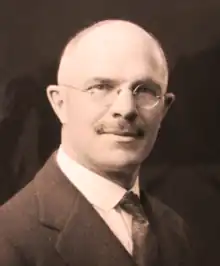
Virgil Snyder (1869, Dixon, Iowa – 1950) was an American mathematician, specializing in algebraic geometry.
In 1886, Snyder matriculated at Iowa State College and graduated with a bachelor's degree in 1889. He attended Cornell University as a graduate student from 1890 to 1892, leaving to study mathematics in Germany on an Erastus W. Brooks fellowship. In 1895, he received a doctorate from the University of Göttingen under Felix Klein. In 1895, Snyder returned to Cornell as an instructor, becoming an assistant professor in 1905 and a full professor in 1910. In 1938, he retired as professor emeritus, having supervised 39 doctoral students, 13 of whom were women.[1] Of these students, perhaps the most well known is C. L. E. Moore. Snyder served as president of the American Mathematical Society for a two-year term in 1927 and 1928.
He was an Invited Speaker of the International Congress of Mathematicians in 1928 at Bologna, in 1932 at Zurich,[2] and in 1936 at Oslo.[3]
Snyder did research on configurations of ruled surfaces and Cremona and birational transformations.[4]
Selected works
- with Charles H. Sisam: Analytic geometry of space. New York: H. Holt & Co. 1914.[5]
References
- ↑ Cornell Math – Early History
- ↑ Richardson, R. G. D. (1932). "International Congress of Mathematicians, Zurich, 1932". Bull. Amer. Math. Soc. 38: 769–774. doi:10.1090/S0002-9904-1932-05491-X. (See p. 772.)
- ↑ Morse, Marston (1936). "The international Congress in Oslo". Bull. Amer. Math. Soc. 42: 777–781. doi:10.1090/S0002-9904-1936-06421-9. (See p. 780.)
- ↑ Coble, Arthur B. (1950). "Virgil Snyder, 1869–1950". Bull. Amer. Math. Soc. 56 (5): 468–471. doi:10.1090/s0002-9904-1950-09413-0. MR 1565227.
- ↑ Winger, Roy Martin (1916). "Review: Analytic Geometry of Space by Virgil Snyder and C. H. Sisam" (PDF). Bull. Amer. Math. Soc. 22 (7): 350–354. doi:10.1090/s0002-9904-1916-02797-2.